| September 04, 2007 |  |
our time will build eternity |
| Previous Issues | Sep 03 | Aug 31 | Aug 30 | Aug 29 | Aug 28 |
Phoenix Takes Flight Phoenix AZ (SPX) Sep 04, 2007
Phoenix AZ (SPX) Sep 04, 2007Phoenix is on its way to Mars. The latest spacecraft in NASA's program of Mars exploration launched from Cape Canaveral on August 4 of this year, and is scheduled to land in the planet's northern polar region on May 25, 2008. Its findings will help scientists answer a critical question about the Red Planet: was it ever habitable? Phoenix is in many ways similar to the two Viking landers ... more Russia plans manned Moon mission by 2025  Moscow (AFP) Aug 31, 2007
Moscow (AFP) Aug 31, 2007Russia plans to send a manned mission to the Moon by 2025 and wants to build a permanent base there shortly after, the head of Russian space agency Roskosmos said Friday. "According to our estimates we will be ready for a manned flight to the Moon in 2025," Anatoly Perminov told reporters. An "inhabited station" could be built there between 2027 and 2032, he said. ... more NASA Study Will Help Stop Stowaways To Mars  Pasadena CA (SPX) Aug 30, 2007
Pasadena CA (SPX) Aug 30, 2007NASA clean rooms, where scientists and engineers assemble spacecraft, have joined hot springs, ice caves, and deep mines as unlikely places where scientists have discovered ultra-hardy organisms collectively known as 'extremophiles'. Some species of bacteria uncovered in a recent NASA study have never been detected anywhere else. According to Dr. Kasthuri Venkateswaran, who led the study ... more Surviving Desert Storm  Pasadena CA (JPL) Aug 31, 2007
Pasadena CA (JPL) Aug 31, 2007After six weeks of hunkering down during raging dust storms that limited solar power, both of NASA's Mars Exploration Rovers, Spirit and Opportunity, have resumed driving. Now the rovers are set to continue their mission, searching for signs of past water on Mars. Liquid water is essential for life as we know it, and therefore the history of water on Mars is vital in determining whether or not ... more Rovers Begin New Observations On Changing Martian Atmosphere  Pasadena CA (SPX) Aug 30, 2007
Pasadena CA (SPX) Aug 30, 2007Mars rover scientists have launched a new long-term study on the Martian atmosphere with the Alpha Particle X-ray Spectrometer, an instrument that was originally developed at the University of Chicago. Thanasis Economou, Senior Scientist at Chicago's Enrico Fermi Institute, suggested the new study after observing that the APXS instruments aboard NASA's twin Mars rovers, Spirit and ... more |
mars-mers
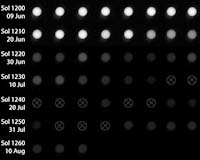 mars-general  mars-life 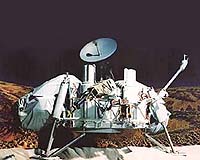 |
 Cleveland OH (SPX) Aug 29, 2007
Cleveland OH (SPX) Aug 29, 2007A rare bird has been flying over the Great Lakes recently, and it isn't migrating or searching for prey. This hawkeyed species is a Learjet aircraft outfitted with an advanced imaging system. Engineers at NASA's Glenn Research Center in Cleveland modified the plane to help the National Oceanic and Atmospheric Administration (NOAA) monitor algae in western Lake Erie and Lake Huron's Saginaw Bay. ... more Recon Orbiter Camera Issue Resolved As 3000th Image Comes Down From Mars  Pasadena CA (JPL) Aug 24, 2007
Pasadena CA (JPL) Aug 24, 2007Diagnostic tests and months of stable, successful operation have resolved concerns raised early this year about long-term prospects for the powerful telescopic camera on NASA's Mars Reconnaissance Orbiter. The High Resolution Imaging Science Experiment (HiRISE) camera on the orbiter has now taken more than 3,000 images of Mars, resolving features as small as a desk in targeted areas covering ... more Mars Rovers Get About As Spirit Clips Viking 2 For Ground Duty  Pasadena CA (JPL) Aug 24, 2007
Pasadena CA (JPL) Aug 24, 2007After six weeks of hunkering down during raging dust storms that limited solar power, both of NASA's Mars Exploration Rovers, Spirit and Opportunity, have resumed driving. Opportunity advanced 13.38 meters (44 feet) toward the edge of Victoria Crater on Aug. 21. Mission controllers were taking advantage of gradual clearing of dust from the sky while also taking precautions against buildup of ... more Brightening Skies Bolster Opportunity For MER-B To Survive 2007 Dust Season  Pasadena CA (SPX) Aug 27, 2007
Pasadena CA (SPX) Aug 27, 2007Opportunity is healthy and remains perched near the rim of "Victoria Crater." The rover was on a low-power schedule that alternated between a 3-sol plan and a 4-sol plan. Tau (atmospheric opacity) has begun to stabilize this week at around 3.7, resulting in solar array energy between 230-240 watt hours. Therefore in the upcoming week, the team will return to nominal planning. ... more |
lunar
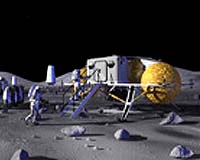 shuttle  shuttle 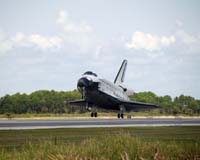 |
 Huntsville AL (MSFC) Aug 22, 2007
Huntsville AL (MSFC) Aug 22, 2007Earth and Mars are converging, and right now the distance between the two planets is shrinking at a rate of 22,000 mph--or about 25 miles per sentence. Ultimately, this will lead to a close approach in late December 2007 when Mars will outshine every star in the night sky. Of a similar encounter in the 19th century, astronomer Percival Lowell wrote the following: ... more Dust From Martian Sky Accumulates On Solar Panels  Pasadena CA (JPL) Aug 22, 2007
Pasadena CA (JPL) Aug 22, 2007Even though the Martian sky above Gusev Crater continued to clear, solar power levels on NASA's Spirit rover remained fairly constant as dust settling from the atmosphere accumulated on top of the solar panels. Activities remained restricted. Measurements of atmospheric opacity, known as Tau, dropped from 3.6 on Martian day, or sol, 1283 (Aug. 12, 2007) to 3.3 on sol 1286 (Aug. 16, 2007) ... more Mars-500 Experiment Could Be Extended To 700 Days  Zhukovsky, Russia (RIA Novosti) Aug 23, 2007
Zhukovsky, Russia (RIA Novosti) Aug 23, 2007A simulated Mars mission, expected to be launched in Russia later this year, could be extended from 500 to 700 days, the head of the Russian Space Agency said Wednesday. Speaking at the MAKS-2007 air show outside Moscow, Anatoly Perminov said: "There are proposals to extend the Mars-500 experiment at the Russian Institute of Medical and Biological Studies...probably to 700 days." ... more Gloomy Skies Show Signs of Clearing  Pasadena CA (JPL) Aug 17, 2007
Pasadena CA (JPL) Aug 17, 2007Spirit is healthy as the amount of dust hoisted into the atmosphere by recent wind storms has leveled off and solar energy levels have held steady at about 280 to 300 watt-hours of energy (100 watt-hours is the amount of energy needed to light a 100-watt bulb for one hour). Since the rover's 1,271st Martian day, or sol, of exploration (July 31, 2007), atmospheric opacity, a measurement known as ... more
|
arctic
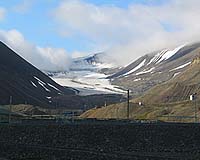 nuclearspace 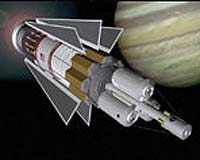 rocketscience 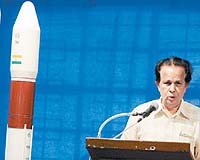 |
| Previous Issues | Sep 03 | Aug 31 | Aug 30 | Aug 29 | Aug 28 |
| The contents herein, unless otherwise known to be public domain, are Copyright 1995-2007 - SpaceDaily. AFP and UPI Wire Stories are copyright Agence France-Presse and United Press International. ESA Portal Reports are copyright European Space Agency. All NASA sourced material is public domain. Additional copyrights may apply in whole or part to other bona fide parties. Advertising does not imply endorsement, agreement or approval of any opinions, statements or information provided by SpaceDaily on any web page published or hosted by SpaceDaily. Privacy statement |